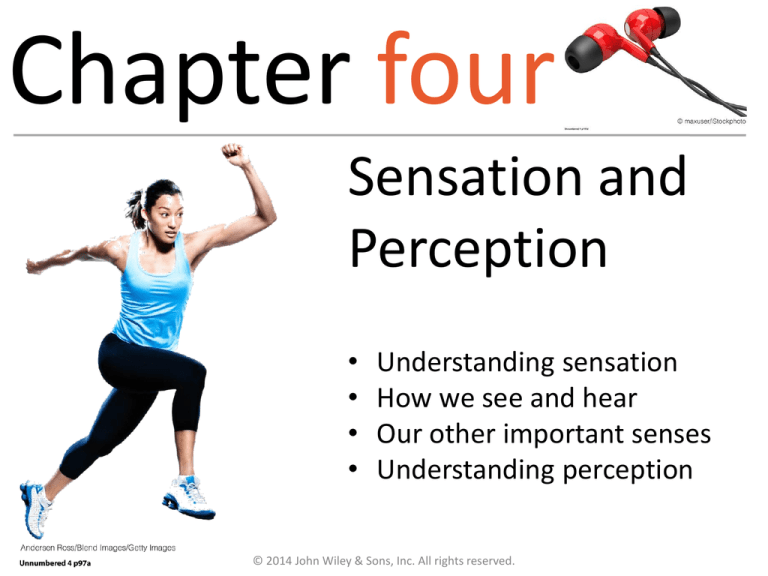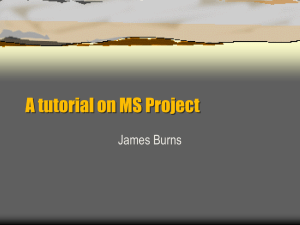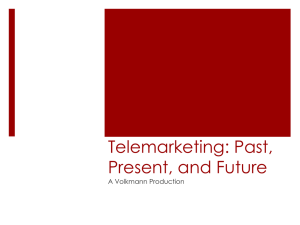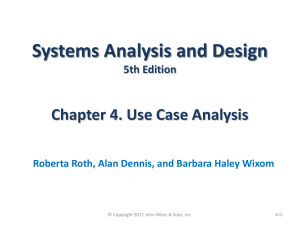
Chapter four
Sensation and
Perception
•
•
•
•
Understanding sensation
How we see and hear
Our other important senses
Understanding perception
© 2014 John Wiley & Sons, Inc. All rights reserved.
realworldpsychology
Things You’ll Learn in Chapter 4
Q1
Do athletes have a higher pain tolerance than
non-athletes?
Q2
Can looking at a photograph of a loved one lead
you to feel less pain?
Q3
How can listening to loud music on headphones
damage your hearing?
Q4
Why do premature babies grow faster when they
receive skin-to-skin contact?
Q5
Why do people rate themselves as more athletic
if they compare themselves to the Pope than to a
professional basketball player?
© 2014 John Wiley & Sons, Inc. All rights reserved.
Understanding Sensation
• While your brain floats in complete silence
and darkness, your body is bombarded with
stimuli from outside.
What are
• Sensing the stimuli is not
some of
enough – our brains must
these stimuli?
receive, convert and adapt
the information into meaningful
representations of the world
© 2014 John Wiley & Sons, Inc. All rights reserved.
Understanding Sensation
• Sensation = process of detecting, converting
and transmitting raw sensory information
from the external and internal environments
to the brain
• Perception = process of selecting, organizing,
and interpreting sensory info into meaningful
patterns
© 2014 John Wiley & Sons, Inc. All rights reserved.
UNDERSTANDING SENSATION
© 2014 John Wiley & Sons, Inc. All rights reserved.
Sensation: the basics
1. Receptor cells in sense organs detect
appropriate stimuli
2. Convert stimuli (transduction) into neural
impulses (action potential)
3. Transmit message to brain through different
routes, allowing brain to differentiate
physical stimuli (coding)
4. Brain assigns meaningful sensory information
© 2014 John Wiley & Sons, Inc. All rights reserved.
Stimulation Overload?
• Some brain structures purposely reduce some
sensory information they receive
• What types of things can humans
What if this
sensory
not detect?
– Ultraviolet light, microwaves,
dog whistle, infrared heat patterns
reduction
didn’t occur?
• Field of psychophysics studies link between
physical stimuli and psychological experience
© 2014 John Wiley & Sons, Inc. All rights reserved.
What Can We Detect?
• Consciously aware of only a narrow range of stimuli at
one time
• Difference Threshold (AKA Weber’s Law of just
noticeable differences or JND) = minimal difference in
stimulus strength that is detectable 50% of the time
(Ernst Weber)
• Absolute Threshold = minimum stimulation needed to
consciously detect stimulus 50% of
the time (Gustav Fechner)
How could these be measured?
© 2014 John Wiley & Sons, Inc. All rights reserved.
Subliminal Stimuli
• Studies on subliminal perception use a tachistoscope
to flash images too quickly for conscious perception
(but slowly enough for the brain to register them)
• At the movies “eat popcorn”? satanic verses when
music is played backward? hidden sexual messages in
Disney films?
Can subliminal stimuli change your behavior?
• Subliminal stimuli are WEAK and don’t
lead to subliminal persuasion
© 2014 John Wiley & Sons, Inc. All rights reserved.
Sensory Adaptation
• Suppose you visit a neighbor’s house with 10 cats.
You smell the animals, but the owner doesn’t.
Why
• Sensory adaptation = when a constant stimulus not?
is presented, the sensory receptors become less
sensitive and fire less frequently
• Normally, smell and touch experience sensory
adaptation readily; vision and intense stimuli do not.
Why? What perspective
in psychology might
explain this?
© 2014 John Wiley & Sons, Inc. All rights reserved.
realworldpsychology
• Intense pain often resists sensory adaptation
to signal danger
Q1
Do athletes have a higher pain
tolerance than non-athletes?
• Endorphins are the body’s natural
painkiller and are released during
physical exertion
– Does the experience of playing sports
change pain tolerance?
– Or are people with high pain tolerance
drawn to athletics?
© 2014 John Wiley & Sons, Inc. All rights reserved.
What about pain?
• Gate-control theory = experience of pain depends on
whether the message gets past the “gatekeeper” in
the spinal cord
– Normally, the gate is shut and pain signals are blocked, but
when body tissue is damaged, impulses open the gate to
allow the message of pain through
– Messages from the brain also control the gate, allowing
some to continue through the pain (athletes, military,
first responders)
© 2014 John Wiley & Sons, Inc. All rights reserved.
realworldpsychology
• Massaging an injury eases discomfort because
pressure on larger-diameter neurons
interferes with pain signals
Q3
Can looking at a photograph of a loved
one lead you to feel less pain?
• Endorphins from the brain, distraction by fear
or competition, actively listening to music – or
looking at a picture – can close the gate and
reduce pain and anxiety
• Focusing on pain amplifies it
© 2014 John Wiley & Sons, Inc. All rights reserved.
What about pain?
• Phantom limb pain = when amputee
continues to feel sensations (pain, tickling) in
the missing limb
• Nerve cells send conflicting messages to the
brain, producing “static” that is interpreted as
pain
• Prosthetic limbs and mirror visual therapy can
help reduce phantom limb pain
© 2014 John Wiley & Sons, Inc. All rights reserved.
HOW WE SEE AND HEAR
© 2014 John Wiley & Sons, Inc. All rights reserved.
Vision
• Receptor cells in retina
(rods and cones) convert
light waves into messages
sent along the optic nerve
© 2014 John Wiley & Sons, Inc. All rights reserved.
Vision Problems
• Visual acuity problems result from small abnormalities in the
shape of the eye, causing the image not to be in focus at the
retina
– Nearsightedness – image reaches focus in front of the retina
– Farsightedness – image reaches focus behind the retina
• Presbyopia – lenses lose elasticity with age
• Blind spot – no receptor cells where the optic nerve exits the
eye
• Rods manage dark adaptation – changing from sunny to dark
environment leaves you temporarily blind
• Cones manage light adaptation – changing from dark to bright
environment activate cones
© 2014 John Wiley & Sons, Inc. All rights reserved.
Hearing
• Outer ear captures sound, three tiny bones in middle ear transmit
eardrum’s vibration to the inner ear where cochlea transforms
waves into neural impulses
© 2014 John Wiley & Sons, Inc. All rights reserved.
Pitch and Volume
• Frequency of sound waves provides information
about pitch of sound
– Place theory for hearing = hair cells at different locations
along the basilar membrane are stimulated by highpitched sounds
– Frequency theory for hearing = hair cells
vibrate at the same low frequency as the
low-pitched sounds they detect
• Loud sounds have higher peaks and
lower valleys than soft sounds,
measured by decibels
© 2014 John Wiley & Sons, Inc. All rights reserved.
Hearing Problems
• Conduction hearing loss (conduction deafness) =
problems with mechanics of sending sound waves to
cochlea. Hearing aids and some surgery help
• Sensorineural hearing loss (nerve deafness) = damage
to hair cells or auditory nerve
Q3
How can listening to loud music on
headphones damage your hearing?
• Result of loud noise, disease, and
biological changes; damage to receptor
cells and auditory nerve is irreversible
© 2014 John Wiley & Sons, Inc. All rights reserved.
OUR OTHER IMPORTANT SENSES
© 2014 John Wiley & Sons, Inc. All rights reserved.
Smell
• Smell and taste are “chemical senses”
because they use chemoreceptors and are
sensitive to chemical molecules
• Olfactory receptors in the nose transduce
info from odorants (molecules with odor)
directly to olfactory bulb at base of frontal
lobe, where info is processed and sent to
other brain regions
• Olfaction is the only sensory system NOT
routed through the thalamus
© 2014 John Wiley & Sons, Inc. All rights reserved.
Taste
• Purpose of taste is to avoid poisonous foods
(which are usually bitter); nonpoisonous
foods with good energy are often sweet
• Dissolved food particles pass over papillae
on the tongue and down into taste buds
(taste receptors), which transduce info to
the brain
• Taste buds are distributed all over the
tongue, NOT in dedicated regions by taste
• Umami – savory; sensitivity to glutamate
found in meat, broth, MSG
© 2014 John Wiley & Sons, Inc. All rights reserved.
Taste Preferences Shaped in Utero
Mennella, Jagnow & Beauchamp, 2001
• Group 1: carrot juice 4x week for 3 weeks during pregnancy
• Group 2: carrot juice 4x week for 3 weeks after baby was born
(breast-feeding mothers)
• Group 3: no carrot juice
• Mothers rated babies’ facial reactions to different foods and
quantity of carrot-flavored cereal
baby would eat
• Babies exposed to carrots in utero
or through breast milk liked the taste
of carrots better
© 2014 John Wiley & Sons, Inc. All rights reserved.
Body Senses – Skin Sense
• Skin sense detects pressure, temperature, and pain
• Touch receptors are most concentrated in face and
hands (that’s why paper cuts hurt!)
Q4
Why do premature babies grow faster
when they receive skin-to-skin contact?
• Kangaroo care – skin-to-skin contact between mother
and baby recommended immediately after birth,
especially for low-birth-weight babies
• Provides warmth, reduces pain, lowers stress arousal,
improves sleep, which leads to growth
© 2014 John Wiley & Sons, Inc. All rights reserved.
Body Senses - Vestibular
• Vestibular sense tells the
brain how our body
(especially head) is oriented
in 3-dimensional space
• Hair cells in the semicircular
canals of the inner ear and in
the vestibular sacs transduce
the position of the head into
neural impulses
© 2014 John Wiley & Sons, Inc. All rights reserved.
Body Senses - Kinesthesis
• Kinesthesis provides information
about body posture, orientation
and movement of individual body
parts
• Kinesthetic receptors in muscles,
joints, and tendons tell the brain
what is moving, how weight is
distributed, where body parts are
in relation to the whole
© 2014 John Wiley & Sons, Inc. All rights reserved.
UNDERSTANDING PERCEPTION
Perception = process of selecting, organizing, and
interpreting incoming sensations into useful mental
representation of the world
© 2014 John Wiley & Sons, Inc. All rights reserved.
Perception Problems
• “Seeing is believing, but seeing isn’t always
believing correctly” (Lilienfeld et al, 2010, p. 7)
What does this mean?
• Illusion = false or misleading impression
produced by errors in the perceptual
process or by actual physical distortions
• Illusions are NOT the same as hallucinations
(false sensory experience WITHOUT
external stimuli) or delusions (false beliefs)
© 2014 John Wiley & Sons, Inc. All rights reserved.
Selection
• Cannot pay attention to all stimuli
• Selective attention = paying attention to important
information and filtering the rest
• Feature detectors = specialized neurons to respond to
specific stimuli, like faces
– Prosopagnosia – inability to identify person by facial features
• Habituation = decrease in responding to repeated
stimulation of same stimuli; more responsive to changes
in environment
– Compliments from strangers are more exciting than from longterm partner!
– The song you HATED on first listen might grow on you!
© 2014 John Wiley & Sons, Inc. All rights reserved.
realworldpsychology
• How do advertisers and political
campaigns use selective attention, feature
detectors, and habituation?
• Capture attention with intense, novel,
moving, contrasting stimuli and repetition
© 2014 John Wiley & Sons, Inc. All rights reserved.
Organization: Form Perception
• Gestalt psychologists studied how the brain
organizes sensory impressions into a “form” or
“whole”
• Figure-Ground: objects are distinct from the
background
© 2014 John Wiley & Sons, Inc. All rights reserved.
Organization: Depth Perception
• Depth Perception: ability to perceive 3dimensional space using binocular and
monocular cues
realworldpsychology
• Visual cliff: crawling
infants refuse to move to
the “deep end”
© 2014 John Wiley & Sons, Inc. All rights reserved.
Organization: Constancies Perception
• Perceive the environment as stable, despite
changes in object’s size, shape, color and
brightness
Why is this important?
© 2014 John Wiley & Sons, Inc. All rights reserved.
Organization: Color Perception
• Trichromatic theory of color = three “color systems”,
each of which is sensitive to red, green and blue;
mixing lights of these three colors yields the full
spectrum of colors
• Opponent-process theory = each of the color
systems is sensitive to two opposing colors
(ex: either blue or yellow)
– Black-and-white systems respond to
differences in brightness
© 2014 John Wiley & Sons, Inc. All rights reserved.
© 2014 John Wiley & Sons, Inc. All rights reserved.
Color-Deficient Vision
• Color confusion on specific color spectrums,
such as red-green or blue-yellow
Is anyone here
“colorblind”? What
is it like?
© 2014 John Wiley & Sons, Inc. All rights reserved.
Organization: Interpretation
• Perceptual set = readiness to perceive stimuli
in a particular manner, based on expectations
• We see what we expect to see
• Frame of reference = perception is influenced
by context
Q5
Why do people rate themselves as more athletic
if they compare themselves to the Pope than to a
professional basketball player?
© 2014 John Wiley & Sons, Inc. All rights reserved.
Processing
• Bottom-up processing = raw sensory data “sent up” to
the brain for higher level analysis
• Top-down processing = perceptual analysis starts “at
the top” with expectations and knowledge driving the
process of perception
• You learn to read from bottom-up processing of letters
and words
• Now, your aiblity to raed uisng top-dwon prcessoing
mkes it psosible to unedrstnad this sntenece desipte its
mnay mssiplllengis
© 2014 John Wiley & Sons, Inc. All rights reserved.
Sixth Sense?
• Extrasensory Perception (ESP) = “psychic” perceptual
abilities that supposedly go beyond the known
senses
– Telepathy, clairvoyance, precognition
• Research in ESP don’t withstand scrutiny, failure to
replicate by rival research labs
• Why do some believe in ESP?
– Motivation and interests influence our perceptions,
creating selective perception
– Strong emotions about the subject mask faulty reasoning
© 2014 John Wiley & Sons, Inc. All rights reserved.
© 2014 John Wiley & Sons, Inc. All rights reserved.









